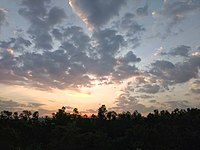Konkan
Konkan | |
|---|---|
Region | |
 DabholinRatnagiri district,Konkan division, Maharashtra. Beaches dotted with swaying coconut palms are a ubiquitous sight along the Konkani coast. | |
 Modern Districts of India forming the Konkan | |
| Coordinates:15°36′N73°48′E/ 15.6°N 73.8°E | |
| Country | |
TheKonkanis a stretch of land by thewestern coastofIndia,bound by the riverDaman GangaatDamaonin the north, toAnjediva Islandnext toKarwartown in the south; with theArabian Seato the west and theDeccan plateauto the east.[1][verification needed]Thehinterlandeast of the coast has numerous river valleys, riverine islands and the hilly slopes known as theWestern Ghats;that lead up into thetablelandsof theDeccan.The region has been recognised by name, since at least the time ofStraboin the third centuryCE.[1]It had a thriving mercantile port withArabtradesmen from the 10th century.[2]The best-known islands of Konkan areIlhas de Goa,the site of theGoa state's capital atPanjim;also, theSeven Islands of Bombay,on which liesMumbai,the capital ofMaharashtra& the headquarters ofKonkan Division.[citation needed]
Definition[edit]
Historically, the limits of Konkan have been flexible, and it has been known by additional names like "Aparanta"and" Gomanchal ", the latter being defined as the coastal area between theDaman Ganga Riverin the north and theGangavalli Riverin the south.[3]
The ancientSapta Konkanwas a larger geographical area that extended fromGujarattoKeralaand included the whole region of coastalMaharashtraandcoastal Karnataka.[1]However, this segment overlaps the Konkan andMalabar coastcontinuum; and usually corresponds to the southernmost and northernmost stretches of these locales respectively.[citation needed]
Etymology[edit]
According to theSahyadrikhandaof theSkanda Purana,Parashuramathrew his axe into the sea and commanded the Sea God to recede up to the point where his axe landed. The new piece of land thus recovered came to be known asSaptah-Konkana,meaning "piece of earth", "corner of the earth", or "piece of the corner", derived fromSanskritwords:koṇa(कोण, corner) +kaṇa(कण, piece).[4][5]Xuanzang,the notedChineseBuddhistmonk, mentioned this region in his book asKonkana Desha;Varahamihira'sBrihat-Samhitadescribed Konkan as a region of India; and 15th-century author Ratnakosh mentioned the word Konkandesha.[1]
Geography[edit]
The Konkan extends throughout the western coasts ofMaharashtra,GoaandKarnataka.[1]It is bounded by theWestern Ghatsmountain range (also known as Sahyadri) in the east, theArabian Seain the west, theDaman Ganga Riverin the north, and theRiver Aghanashiniin the south. The Gangavalli flows in the district ofUttara Kannadain present-dayKarnataka.Its northern bank constitutes the southernmost portion of Konkan. The towns ofKarwar,Ankola,Kumta,Honavar,andBhatkalfall within the Konkan coast. The largest city on the Konkan coast isMumbai,the state capital ofMaharashtra.Districts on the Konkan coast are, from north to south:[6]
- Damaondistrict
- Palghar district
- Thane district
- Mumbai Suburban district
- Mumbai City district
- Raigad district
- Ratnagiri district
- Sindhudurg district
- North Kanara(Karwar to Bhatkal)
Ethnology[edit]
The main ethnolinguistic group of the Konkan region is theKonkani people.Specific caste and communities found in the region are theAagri,Koli,Bhandari,Kunbi,Maratha,Gabit,Mangela, Karadi, Phudagi, Vaiti,Kharvi,Teli,Kumbhar,Nhavi,Dhobi,Kasar,Sutar,Lohar,Chambhar,Mahar,Dhangar,Gaud Saraswat Brahmin(also includes Rajapur Saraswats and Chitrapur Saraswats),Kudaldeshkar,Pathare Prabhu,Gomantak Maratha,Chitpavan Brahmins,Karhade Brahmins,Daivadnya,Kayastha Prabhu,Panchkalshi,Vani,Komarpant,VadvalGavli,Ghorpi, Nath Jogi,Gurav,Pagi, Kalan, Ghadi, Padti, Vanjari,Namdev Shimpiand others.Billava,Bunt,Nadavara,Mogaveeraand Linghayat communities found in the parts of Karnataka which are near to Konkan.
Tribal communities include theKatkari,Thakar,Konkana,Warliand Mahadev Koli, mainly found in the northern and central parts of Konkan. TheDublaandDhodiatribes live in southernGujarat,Dadra and Nagar HaveliandPalghar districtofMaharashtra.Palghar district has the largest percentage of tribal population in Konkan. A small nomadic tribe called the Vanarmare is found in southern parts of Konkan, which was originally associated with the hunting of monkeys. TheGaudaand Velip tribes are found in Goa.
The Jewish community calledBene Israelis mainly found inRaigad district.The Christians includedBombay East Indiansin North Konkan andMumbai,Goan CatholicsinGoa,Karwari CatholicsinUttara Kannadaas well asMangalorean CatholicsinUdupiandDakshina Kannada.
Major Muslim communities likeKonkani MuslimsandNawayathsare scattered throughout the whole region. They are reportedly descendants of people who came fromHadhramaut(inYemenorSouth Arabia),[7]and other parts ofArabiaand theMiddle East.TheSiddishave their roots inAfrica.[2]
See also[edit]
- People of the Konkan Division
- Konkan Railway
- Jaitapur Nuclear Power Project
- Malabar Coast
- Coromandel Coast
References[edit]
- ^abcdeSaradesāya, Manohararāya(2000). "The Land, the People and the Language".A History of Konkani Literature: From 1500 to 1992.India: Sahitya Akademi. pp. 1–14.ISBN978-8-1720-1664-7.
- ^abWink, André (1991).Al-hind: The Making of the Indo-islamic World.Brill.p. 68.ISBN978-90-04-09249-5.
- ^De Souza, Teotonio R., ed. (1990).Goa Through the Ages: An economic history - Volume 2.India: Concept Publishing Company. pp. 8–9.ISBN9788170222590.
- ^Shastri Gaytonde, Gajanan (ed.).Shree Scanda Puran (Sayadri Khandha)(in Marathi). Mumbai: Shree Katyani Publication.
- ^Satoskar, B. D.Gomantak Prakruti ani Sanskruti.Part 1 (in Marathi). Shubhada Publication. p. 206.
- ^Limited, Nigade Software Technologies (opc) Private."Konkan Division District List (कोंकण विभाग जिल्हा यादी)".swapp.co.in.Retrieved26 January2022.
- ^Khalidi, Omar(1996),"The Arabs of Hadramawt in Hyderabad",in Kulkarni; Naeem; De Souza (eds.),Mediaeval Deccan History,Bombay:Popular Prakashan,ISBN978-8-1715-4579-7
External links[edit]
 Konkantravel guide from Wikivoyage
Konkantravel guide from Wikivoyage- Konkan Tourism– a complete guide on tourism
- Konkan Hotels
- Tourist Place to visit Konkan Darshan


